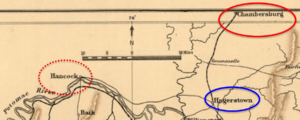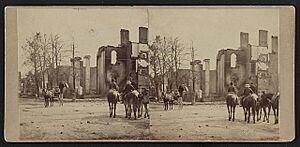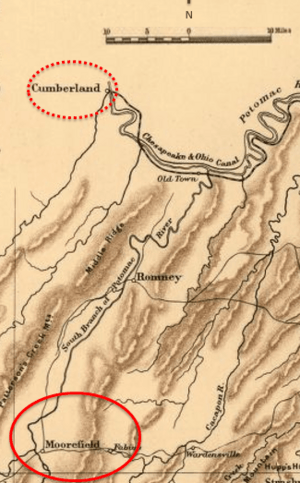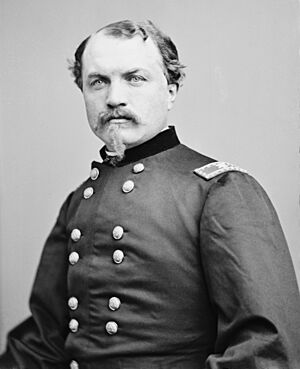Battle of Moorefield facts for kids
Quick facts for kids Battle of Moorefield |
|||||||
|---|---|---|---|---|---|---|---|
| Part of the American Civil War | |||||||
 Hardy County, West Virginia, US |
|||||||
|
|||||||
| Belligerents | |||||||
| Commanders and leaders | |||||||
| Units involved | |||||||
| 1st West Virginia Cavalry 2nd West Virginia Cavalry (reserve) 3rd West Virginia Cavalry 1st New York Cavalry 8th Ohio Cavalry 14th Pennsylvania Cavalry 22nd Pennsylvania Cavalry |
1st Maryland Cavalry 2nd Maryland Cavalry 36th Battalion, Virginia Cavalry 37th Battalion, Virginia Cavalry 8th Virginia Cavalry 14th Virginia Cavalry 21st Virginia Cavalry 22nd Virginia Cavalry |
||||||
| Strength | |||||||
| 1,760 | 3,000 | ||||||
| Casualties and losses | |||||||
| 42 | 488 | ||||||
The Battle of Moorefield was an important cavalry battle during the American Civil War. It happened on August 7, 1864, near Moorefield, West Virginia. This battle was part of a larger plan by Confederate General Jubal Early to raid Union areas.
The Union army, led by Brigadier General William W. Averell, won a big victory here. It was the last major battle in this area before General Philip Sheridan took charge of Union troops. Averell was known for doing well when he was in charge on his own. This battle was his third major win, showing his skill as a leader.
In late July 1864, Confederate cavalry, led by Brigadier General John McCausland, crossed into Pennsylvania. They burned much of Chambersburg, Pennsylvania, and then moved to threaten other towns. They also aimed to disrupt the Baltimore and Ohio Railroad. Averell's smaller Union cavalry force chased McCausland.
McCausland's troops, with fresh horses, managed to escape Averell for a time. After crossing back into West Virginia, McCausland set up camp near Moorefield, West Virginia. He divided his forces, with one group north of the South Branch of the Potomac River and another south. He thought Averell was still far away. However, Averell was closer than McCausland realized and was ordered to continue the chase.
On the night of August 6, Averell's cavalry moved carefully toward the Confederate camps. They used scouts dressed as Confederate soldiers to capture enemy pickets (guards) quietly. This allowed Averell's men to get very close to the sleeping Confederates without being noticed.
Early on August 7, Averell's first group attacked the Confederates north of the river. Many Confederate soldiers were caught off guard, some still sleeping. They tried to run away, leaving behind their weapons and things they had taken from Chambersburg. Even the Confederates south of the river were unprepared. Averell sent his second group to charge across the river. The Confederates were disorganized and couldn't stand against Averell's cavalry. Union soldiers had powerful weapons like sabers, 6-shot revolvers, and 7-shot repeating rifles.
The Union force lost fewer than 50 men, while the Confederates lost over 400, either killed or captured. This victory badly hurt the Confederate cavalry in the Shenandoah Valley. It was never as strong again after this battle.
Contents
Why the Battle Happened
Confederate Raids and Union Pursuit
In the summer of 1864, Confederate forces under General Jubal Early were active in the Shenandoah Valley. Early's successes worried President Abraham Lincoln. Union leaders had to send soldiers to the area.
General Early sent two cavalry groups, led by General John McCausland and General Bradley Tyler Johnson, to raid northern towns. Their goal was to burn towns if they didn't receive money. Their first targets were Chambersburg, Pennsylvania, and Cumberland, Maryland.
On July 29, McCausland's cavalry crossed the Potomac River. Panic spread as they moved toward Chambersburg. Union General William W. Averell was nearby in Hagerstown, Maryland. Averell had fewer men than McCausland. Averell's communication lines were cut.
Averell was under pressure to protect Washington D.C. and Baltimore. He thought the Confederates were heading for Baltimore. This mistake delayed his arrival in Chambersburg. Because of this, McCausland's troops were able to raid and burn Chambersburg on July 30. The town was badly damaged, with hundreds of homes and businesses destroyed.
After burning Chambersburg, McCausland moved west. Averell arrived later and continued to chase him. Averell's pursuit may have saved other towns from being burned.
McCausland then planned to burn Hancock, Maryland, because he didn't get a ransom. This caused a big disagreement between McCausland and General Johnson. Johnson was from Maryland and strongly disagreed with burning the town. He even told some of his men to protect the residents. This near-rebellion ended when Averell's cavalry got close.
Averell's men fought with McCausland's rear guard. McCausland had gotten fresh horses and escaped. Averell's horses were tired, so he had to rest his troops in Hancock. He couldn't find fresh horses because McCausland had already taken them. Averell rested until August 3, when he was ordered to continue chasing McCausland and attack him.
McCausland Moves South
When Averell got his new orders, McCausland's troops had already threatened Cumberland. General Benjamin Franklin Kelley used artillery to stop McCausland. McCausland then crossed the Potomac River and camped near Springfield, West Virginia. The next day, they moved to Romney, West Virginia, and rested.
On August 4, the Confederates tried to attack New Creek (now Keyser, West Virginia). They wanted to damage the Baltimore and Ohio Railroad. General Kelley sent more soldiers by train to defend New Creek. The Confederates faced strong defenses and difficult land. They had to retreat south and give up their attack.
After this failed attack, the Confederates went south toward Moorefield. McCausland still thought Averell was far away. He chose campsites that were good for feeding horses, not for defense. Johnson's group camped north of the South Branch Potomac River, and McCausland's group camped south of it. These camps were between Moorefield and Romney, closer to Moorefield.
McCausland set up his headquarters in Moorefield, about three miles from his troops. His horses were unsaddled and fed. Captain John Hanson McNeill, a local Confederate leader, warned McCausland that the camps were not safe. But his advice was ignored. McNeill moved his own group, McNeill's Rangers, to a safer spot.
Averell Renews the Chase
While the Confederates were attacking New Creek, Averell's force crossed the Potomac at Hancock. They headed for Springfield, West Virginia. Averell's horses were very tired. But at Springfield, General Kelley sent food for Averell's men and horses. Averell learned that McCausland was moving toward Moorefield.
Averell reached Romney around 11:00 AM on August 6. He sent a group of men to block McCausland's escape route back to the Shenandoah Valley. Averell then gathered more information and planned a surprise attack.
Averell's main force started moving south at 1:00 AM on August 7. A group of scouts, dressed in Confederate uniforms, led the way. The main force followed far behind so they wouldn't be seen. These scouts were chosen for their special mission. They moved slowly, often stopping to make sure the path was clear. Soldiers would rest by the road, holding their horses, waiting for the scouts to signal it was safe.
Around 2:30 AM, the scouts tricked and captured two Confederate guards. From these guards, they learned where the next guards were. They quietly captured two more groups of Confederate guards along the main road.
The Battle Begins
Averell's Surprise Attack
Averell's troops approached Johnson's Confederate group from the north. Captain Kerr's scouts, still dressed as Confederates, led the way. Averell's First Brigade, led by Major Thomas Gibson, followed. This group included the 14th Pennsylvania Cavalry and the 8th Ohio Cavalry. Averell wanted Gibson's men to attack with their sabers and push toward the river. Averell himself rode with this group. Surprise was key because Averell's force was smaller (1,760 men) than McCausland's (3,000 men).
The Second Brigade, led by Colonel William H. Powell, followed. It had three West Virginia cavalry regiments and the 1st New York Cavalry. Powell's men rode on both sides of Gibson's Brigade. The 2nd West Virginia Cavalry stayed in reserve and guarded the captured Confederate pickets. Further east, Major George T. Work's 22nd Pennsylvania Cavalry battalion was moving toward Moorefield.
At dawn, Kerr's scouts rode past the Confederate 1st Maryland Cavalry regiment. They went to the McNeill house, where General Johnson had his headquarters. This area was near a small community called Old Fields, West Virginia, so sometimes the battle is called the Battle of Oldfields. No shots were fired until Kerr reached the house.
Then, Averell's advance group, led by Major Gibson, attacked. Gibson's men quickly made the Confederate 1st Maryland Cavalry and then the 2nd Maryland Cavalry run away. Many Union soldiers shouted "Remember Chambersburg!" as they attacked. About 200 Confederates from the Maryland cavalry were captured.
Gibson's group continued south, waking up the 37th Battalion, Virginia Cavalry. This unit also fled in all directions. Next, they faced the 36th Battalion, Virginia Cavalry. This group fought harder, but they were surprised and forced to retreat toward the McNeill farm. Near the McNeill house, Confederate artillery tried to fire their cannons. But the Union 8th Ohio Cavalry captured them before they could shoot. General Johnson barely escaped capture from his headquarters. He jumped on a horse and rode south to the 8th Virginia Cavalry.
The 8th Virginia Cavalry had enough warning to get ready and form a battle line. After a close fight, the 8th Virginia was overwhelmed. They joined other Confederates running toward the river. During this fight, Captain Kerr, who led Averell's scouts, was wounded and his horse was killed. His wounds were not serious, and he managed to capture the 8th Virginia's battle flag with his saber. He later received the Medal of Honor for his bravery.
General Johnson noted that his men had few sabers, which was a disadvantage in cavalry fights. He said their one-shot muskets were useless after being fired against charging sabers.
Colonel William E. Peters managed to get his 21st Virginia Cavalry Regiment ready. But they were also pushed back across the river. Peters had been arrested earlier for refusing to burn Chambersburg, but the arrest was quickly canceled. He led the rear guard when they left Chambersburg. At Moorefield, he fought well, slowing the Union advance on the south side of the river.
Fighting at the River
McCausland's Brigade was on the south side of the South Branch of the Potomac River. The 14th Virginia Cavalry was camped closest to the ford (river crossing). They faced a mix of Union and Confederate soldiers crossing the river. For a short time, they slowed Gibson's Brigade, which was getting spread out. Lieutenant Colonel John T. Radford ordered the 22nd Virginia Cavalry to join the fight.
Averell expected resistance at the river. He had Powell's Brigade ready. Major Seymour B. Conger led the 3rd West Virginia Cavalry across the river. On the other side, the Lincoln Cavalry crossed without opposition. The New Yorkers went behind the 22nd Virginia, forcing them to retreat from the riverbank.
Averell's men were angry at McCausland for burning Chambersburg. In their rush, they didn't guard their prisoners well. Many captured Confederates from Johnson's Brigade escaped. General Johnson and Colonel Peters also crossed the river. Johnson expected to find McCausland ready for battle. But McCausland was in Moorefield, three miles away. Johnson and Peters gathered some men and formed a battle line. They fired at Gibson's Brigade, but Gibson was quickly reinforced. Peters was seriously wounded.
The Union cavalry continued their charge into McCausland's camp. The 16th Virginia Cavalry fled without fighting. Conger's 3rd West Virginia turned east and chased fleeing Confederates down the road toward Wardensville and Winchester. The 17th Virginia Cavalry was camped near some woods and had more time to prepare. They formed a battle line and initially pushed back Conger's men.
However, Colonel Powell and the 1st West Virginia Cavalry reinforced Conger. The two regiments charged the Virginians, driving them down the road or into the woods. During this, Major Conger was killed by a Confederate lieutenant wearing a blue coat, which made Conger think he was a Union soldier. The West Virginia regiments continued to chase the Confederates and captured McCausland's two cannons. Some fleeing Confederates ran into Major Work's 22nd Pennsylvania and had to scatter into the woods. Work's men captured 34 of them.
The fighting and chase lasted for about four miles until the Confederates were too scattered to pursue further. Many Confederates were afraid of being caught with stolen money and items from Chambersburg. This made them desperate to escape, and they left their loot behind. A lot of money was found in the Confederate camps.
What Happened After the Battle
The Battle of Moorefield was the last of seven battles in Early's campaign against the B&O Railroad. One Union soldier estimated that the Confederates lost about 800 men. The National Park Service says Confederate casualties were around 500. Averell reported capturing 38 officers and 377 enlisted men, and killing at least 13 while wounding 60. Many captured Confederates escaped because the Union advance was so fast. Averell's forces lost 11 killed, 18 wounded, and 13 captured. The captured Union soldiers were likely stragglers found by McNeill's Rangers.
The bad feelings between Johnson and McCausland continued after the defeat. They blamed each other. McCausland said the battle was caused by Johnson's group being surprised. He also claimed he knew Averell was coming and gave orders to prepare. Johnson said he followed all orders, including where to camp and place guards. He also pointed out that McCausland was sleeping three miles away when his group was attacked. Johnson also complained about the Confederate soldiers' bad behavior in Pennsylvania and Maryland, saying they took watches, jewelry, and robbed homes.
Moorefield was another big win for Averell. He often did well when he was in charge on his own. He had already won battles at Droop Mountain and Rutherford's Farm. He was one of the few Union cavalry leaders to succeed in the East before General Philip Sheridan arrived. One Union major called Averell's victory at Moorefield "one of the most brilliant achievements of the war." Another major said it was "one of the most signal victories for the Union cause."
This big loss severely weakened Early's cavalry in the Shenandoah Valley. It became half its original size, and two of its best groups were badly damaged. The loss also made the remaining Confederate cavalry feel discouraged. Early later wrote that the battle had a "very damaging effect" on his cavalry for the rest of the campaign. The Union victory also marked the beginning of the Union cavalry becoming the stronger force in the Shenandoah Valley.
Images for kids












